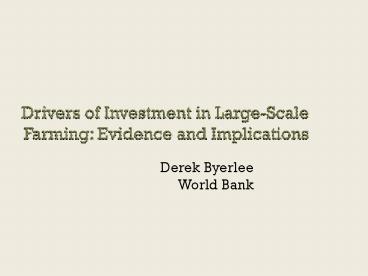Drivers of Investment in LargeScale Farming: Evidence and Implications - PowerPoint PPT Presentation
1 / 27
Title:
Drivers of Investment in LargeScale Farming: Evidence and Implications
Description:
area of 6 m ha by 2020. D j vu--'plantation crops' sugarcane, oil palm, jatropha? ... have led to conflict, injury, intimidation, arrests, torture and even death' ... – PowerPoint PPT presentation
Number of Views:92
Avg rating:3.0/5.0
Title: Drivers of Investment in LargeScale Farming: Evidence and Implications
1
Drivers of Investment in Large-Scale Farming
Evidence and Implications
- Derek Byerlee
- World Bank
2
Large-Scale Land Acquisitions, 2004-08One
African Country
- Distribution of Applications
- Number for Agriculture (and average hectares)
3
What are Major DriversDemand Side
- Food security
- FDI by food importing countries with Yuans
Dinars to invest - The scramble for biofuels
- Domestic and exports
- Domestic investors
- Expectations of payments for avoided
deforestation? - Speculation?
4
Potential land and water available for expansion
of farming
available water utilized
5
Projected Cereal ImportsIFPRI Baseline
2008 Export bans were a major concern
6
GRAINs Land Grab Map
Foreign Investment Only
7
Land Allocation, Sudan
8
Projections of Biofuels in the Tropics
9
Biofuels will Drive Further Rapid Expansion of
Oil Palm in SE Asia
Projected additional area of 6 m ha by 2020
10
Expansion for Oil Palm for Biodiesel, Colombia
11
But Why Large Scale?
- Déjà vu--plantation cropssugarcane, oil palm,
jatropha? - Well established reasons to favor large scale
(plus outgrowers) - New technologies and management tools
- ICT, precision agriculture, remote control (Agadi
Farms) - Global farming by Wall St
- e.g., Altima IFC venture
- From small is beautiful to bigger is better
thinking - Some academics, governments
12
So What if it is Large Scale?
- A major opportunity
- with significant risks
- Opening of land abundant and remote regions
- Export development
- New industries--biofuels
- Employment generation
- Technology transfer
- Lack of attention to existing land users
- Undermining of governance
- Short-term interests
- Negative environmental externalities
13
WB-IIED-FAO Study to Address Four Key Questions
- What is really happening on the ground?
- Quantification and characterization of investment
projects. - Is the policy, legal and institutional
environment adequate? - Diagnosis of gaps and capacities
- Are these sound investments?
- Financial and economic analysis of projects
- What about social and environmental impacts?
- Analysis of positive and negative impacts
14
The Countries Selected (30)(based on activity
level, region, nature of land markets)
15
Two Phases
- Phase 1
- National (or state)
- Inventory of projects and policy review
- Being piloted in eight countries
- Phase II
- Field based for a subsample of projects and
countries - Project specific financial, economic, social and
environmental assessments
16
The Project Inventory
- A country-specific database
- Of investments and proposals involving land
acquisition (gt 500 - 5000 ha) - Ha, crops/enterprises, type of investor,
outgrowers? - Status of investment
- Pipeline, approved, under implementation
- Uses a variety of sources investment promotion
agency, ministries of land, NGOs and other key
informants - Geo-referenced to facilitate economic, social and
environmental impact analyses
17
The Policy Review
- A diagnostic tool based on the land governance
toolkit - To identify adequacy of policies, legal
frameworks and institutional capacities - Based on 42 indicators to asses
- the processes through which land is made
available - the processes through which investments are
selected - the requirements to carry out and publicize
social and environmental impact assessments - the institutional capacity to implement these
policies
18
Financial and Economic Analysis
- If a financial analysis is available
- Tire check the yield and other technical
parameters - Realism of price assumptions (2008?)
- Economic analysis
- Particular focus on opportunity cost of land in
existing uses - Often use zero cost of land!
- Take account of large incentive/subsidies
provided by government - Biofuel mandates, infrastructure,
19
Large-Scale Farming and Poor Yields in Sudan
20
The Tricky Economics of Biofuel
21
Environmental Assessment
- For a subset of investment proposals, the study
will examine - Safeguards in place
- What environmental considerations were taken into
account - Features of the project design to mitigate
environmental impacts - Review of actual/potential indirect effects
- Land expansion elsewhere due to prices, lack of
regulations - Use of geo-referenced data
22
Impacts of Large-Scale Farming and Forest
Plantations, Riau, Indonesia
1 M ha
23
Social Impacts
- Analysis of the macro context
- Existing social, political and historic situation
- Key land and natural resource tenure issues
related to disadvantaged groups - Analysis of specific investments
- Process of consultation
- Social impact assessment process
- Compensation mechanisms and arrangements with
local communities - Benefit sharing
24
Oil Palm is a Source of Conflicts in Indonesia,
2008
25
Worst Case Scenarios!
- Land tenure disputes have led to conflict,
injury, intimidation, arrests, torture and even
death - CIFOR review, Indonesia, 2008
- Various studies indicate that in many cases the
expansion of palm cultivation has been conducted
with serious human rights violations, including
forced displacement, massacres, threats, land
confiscation and murders - Social impact analysis, Colombia, 2008
26
The Product
- Empirical
- Some in-depth country studies
- Global data, trends and drivers
- Overall assessment of benefits and risks
- Policy guidance
- Good practice guidelines and examples
- Timetable
- Phase 1March/April
- Phase IIMay-Aug
- SynthesisSept--Dec
27
Conclusions and Implications
- New wave of large scale land acquisitions with
new drivers and actors - Major new opportunity but significant risks for
land governance - The natural resources curse?
- Additional research is needed
- Better evidence of what is happening on the
ground - Holistic view of costs and benefits
- Understanding of the renewed interest in
large-scale farming - Priority to build land governance capacity to
manage the risks - Adequate policies and regulations
- Capacity to process, implement and monitor































